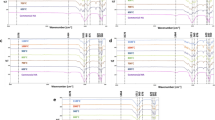Abstract
This investigation synthesized and characterized hydroxyapatite (HAP) microspheres, agglomerated microspheres, and implants containing ciprofloxacin. This delivery system is to be used as an implantable drug delivery system for the treatment of bone infections. The HAP microspheres were made by chemical precipitation followed by a spray-drying technique. Agglomerated microspheres were prepared by a wet granulation process using a granulator. Implants were prepared by direct compression of the granules on a Carver press. Ciprofloxacin was analyzed by high-performance liquid chromatography. Characterization of the HAP microspheres include particle size, size distribution, physical state of the drug in the microsphere, and microstructure of the drug delivery system before and after in vitro release. The particle size, porosity, and morphology of the microspheres were dependent on viscosity and concentration of the slurry as well as the atomization pressure used during spray drying. Even at the highest drug load (2% wt/wt), the drug was present in a noncrystalline state. The drug release from the agglomerated microspheres was quick and almost complete within 1 hour. However, compressing the same amount of agglomerated microspheres into an implant greatly reduced the rate of ciprofloxacin release. Only 12% (wt/wt) of the drug was released from the implant within 1 hour.
The in vitro release of ciprofloxacin from these implants follows a diffusion-controlled mechanism. This method provides a unique way of producing various shapes and drug loads of HAP microspheres that can be easily manufactured on a commercial scale.
Similar content being viewed by others
References
Dash AK, Suryanarayanan R. An implantable dosage form for the treatment of bone infections. Pharm Res. 1991;9:993–1002.
Danckwerts M, Fassihi A. Implantable controlled release drug delivery systems: a review. Drug Dev Ind Pharm. 1991;17:1465–1502.
Dash AK, Cudworth GC II. Therapeutic applications of implantable drug delivery systems. J Pharmacol Tox Meth. 1998;40:1–12.
Morris L, Bajpai PK. Development of a resorbable tricalcium phosphate (TCP) amine antibiotic composite. In: Hanker JS, Giammara BL, eds. Biomedical Materials and Devices. Pittsburgh, PA: Materials Research Society; 1989;293–300.
Bajpai PK. Ceramic implantable drug delivery system. Trend Biomet Art Org. 1989;3:50–60.
Otsuka M, Matsuda Y, Yu D, Wong J, Fox JL, Higuchi WL. A novel skeletal drug delivery system for anti-bacterial drugs using self setting hydroxyapatite cement. Chem Pharm Bull. 1990;38:3500–3503.
Yu D, Wong J, Matsuda Y, Fox J, Higuchi WI, Otsuka M. Self setting hydroxyapatite cement: A novel skeletal drug delivery system for antibiotics. J Pharm Sci. 1991;81:529–531.
Kamegai A, Shimamura N, Naitou K, Nagahara K, Kanematsu N, Mori M. Bone formation on the influence of bone morphogenetic protein/self-setting apatite cement composite. Biomed Mater Eng. 1994;4:291–307.
Otsuka M, Nakahigashi Y, Matsuda Y, Fox JL, Higuchi WI. A novel skeletal drug delivery system using a self-setting calcium phosphate cement: VII. Effect of biological factors on indomethacin release from the cement loaded on bovine bone. J Pharm Sci. 1994;83:1569–1573.
Itokazu M, Matsunaga T, Kumazawa S, Yang W. A novel drug delivery system for osteomyelitis using porous hydroxyapatite blocks loaded by centrifugation. J Appl Biomater. 1995;6:167–169.
Luo P. Method of synthesizing HAP powders and bulk materials. US patent 5 858 318. January, 12, 1999.
Luo P, Nieh TG. Preparing hydroxyapatite powders with controlled morphology. Biomaterials. 1996;17:1959–1964.
Cohen S, Yoshioka T, Lucarelli M, Hwang L, Langer R. Controlled delivery systems for proteins based on poly (lactic/glycolic acid) microspheres. Pharm Res. 1991;8:713–720.
Dash AK, Haney PW, Garavalia MJ. Development of an in vitro dissolution method using microdialysis sampling technique for implantable drug delivery systems. J Pharm Sci. 199988:1036–1040.
Higuchi T. Rate of release of medicaments from ointment bases containing drugs in suspensions. J Pharm Sci. 1961;50:874–875.
Pham HH, Luo P, Génin F, Dash AK. Preparation and characterization of hydroxyapatite microspheres containing ciprofloxacin. AAPS Pharm Sci. 1999;1(suppl):S-373.
Author information
Authors and Affiliations
Corresponding author
Additional information
Published: January 28, 2002.
Rights and permissions
About this article
Cite this article
Pham, H.H., Luo, P., Génin, F. et al. Synthesis and characterization of hydroxyapatite-ciprofloxacin delivery systems by precipitation and spray drying technique. AAPS PharmSciTech 3, 1 (2002). https://doi.org/10.1208/pt030101
Received:
Accepted:
DOI: https://doi.org/10.1208/pt030101




